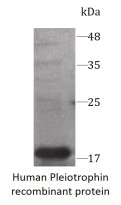ARG70456
Human Pleiotrophin recombinant protein (His-tagged, C-ter)
Human Pleiotrophin recombinant protein (His-tagged, C-ter) for SDS-PAGE
Overview
| Product Description | E. coli expressed, His-tagged (C-ter) Human PTN recombinant protein |
|---|---|
| Tested Application | SDS-PAGE |
| Target Name | PTN |
| Species | Human |
| A.A. Sequence | Gly33 - Asp168 |
| Expression System | E. coli |
| Protein Full Name | Pleiotrophin |
| Alternate Names | PTN; Pleiotrophin; HBNF; HBGF8; NEGF1; Heparin-Binding Neurite Outgrowth-Promoting Factor 1; Heparin-Binding Growth-Associated Molecule; Heparin-Binding Growth Factor 8; Heparin-Binding Brain Mitogen; Osteoblast-Specific Factor 1; HB-GAM; HBGF-8; HBNF-1; OSF-1; HBBM |
Properties
| Form | Powder |
|---|---|
| Purification Note | Endotoxin level is less than 0.1 EU/µg of the protein, as determined by the LAL test. |
| Purity | > 98% (by SDS-PAGE) |
| Buffer | PBS (pH 7.4) |
| Reconstitution | It is recommended to reconstitute the lyophilized protein in sterile water to a concentration not less than 200 μg/mL and incubate the stock solution for at least 20 min at room temperature to make sure the protein is dissolved completely. |
| Storage Instruction | For long term, lyophilized protein should be stored at -20°C or -80°C. After reconstitution, aliquot and store at -20°C or -80°C for up to one month. Storage in frost free freezers is not recommended. Avoid repeated freeze/thaw cycles. Suggest spin the vial prior to opening. |
| Note | For laboratory research only, not for drug, diagnostic or other use. |
Bioinformation
| Gene Symbol | PTN |
|---|---|
| Gene Full Name | Pleiotrophin |
| Background | The protein encoded by this gene is a secreted heparin-binding growth factor. The protein has significant roles in cell growth and survival, cell migration, angiogenesis and tumorigenesis. Alternative splicing and the use of alternative promoters results in multiple transcript variants. |
| Function | Binds PTPRZ1, leading to neutralization of the negative charges of the CS chains of PTPRZ1, inducing PTPRZ1 clustering, thereby causing the dimerization and inactivation of its phosphatase activity leading to increased tyrosine phosphorylation of each of the PTPRZ1 substrates like ALK, CTNNB1 or AFAP1L2 in order to activate the PI3K-AKT pathway. |
| Cellular Localization | Secreted |
| PTM | Disulfide bond |
Images (1) Click the Picture to Zoom In






